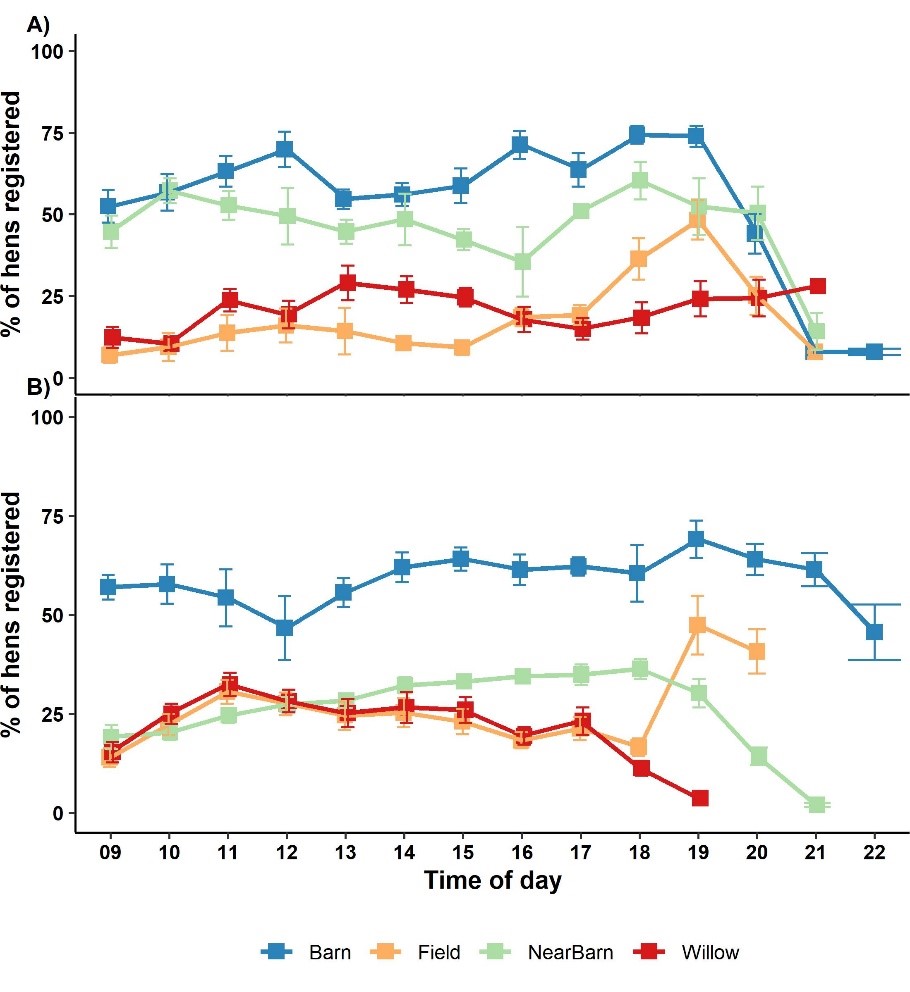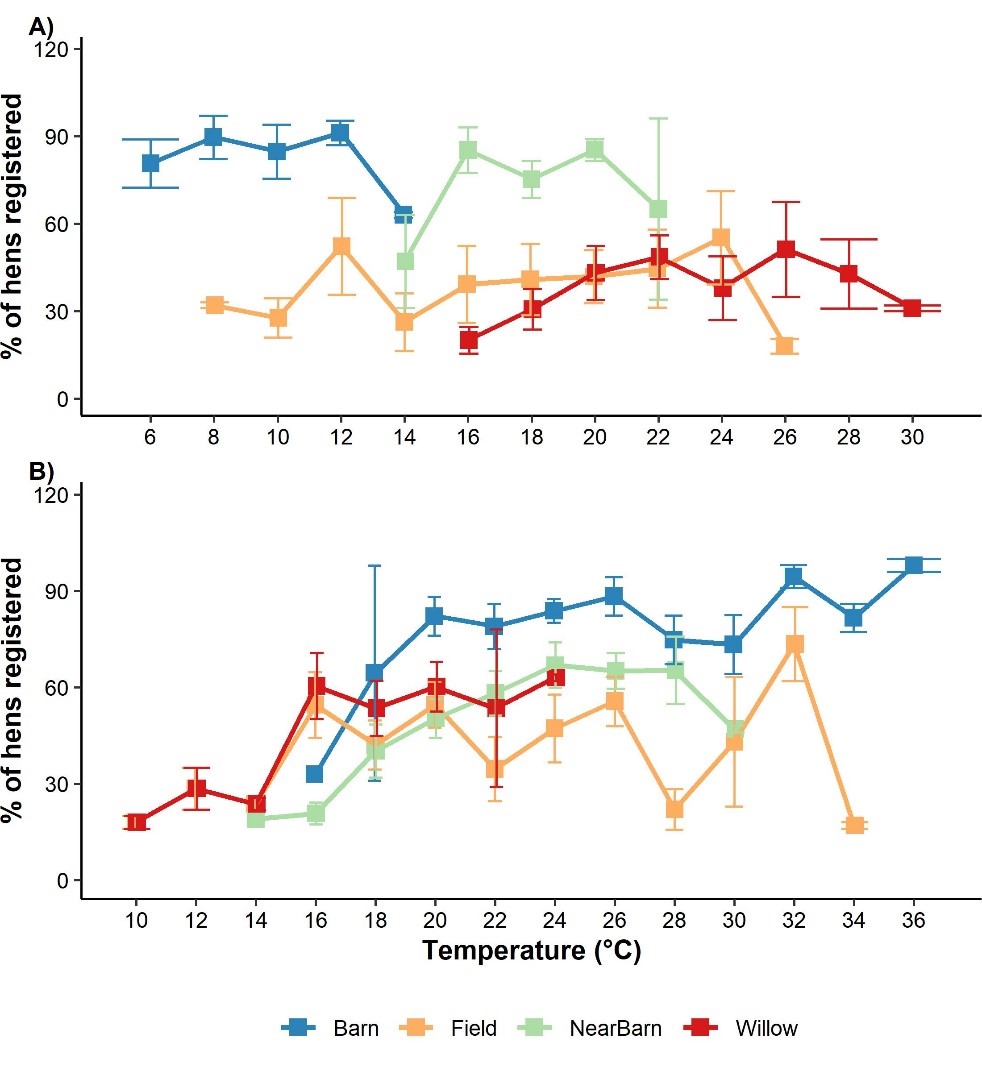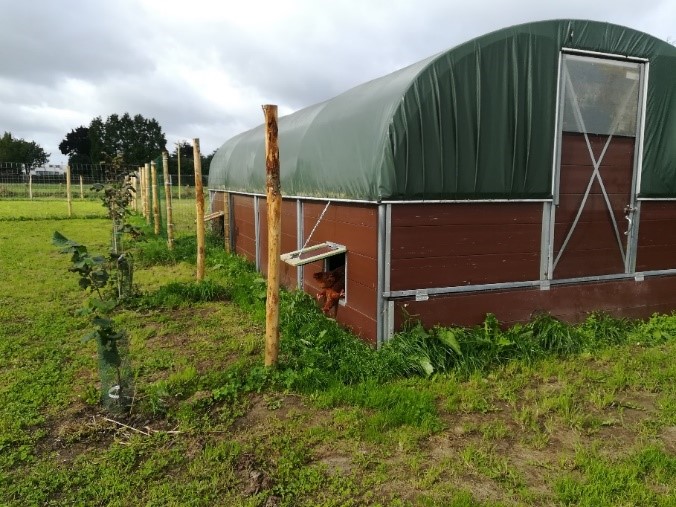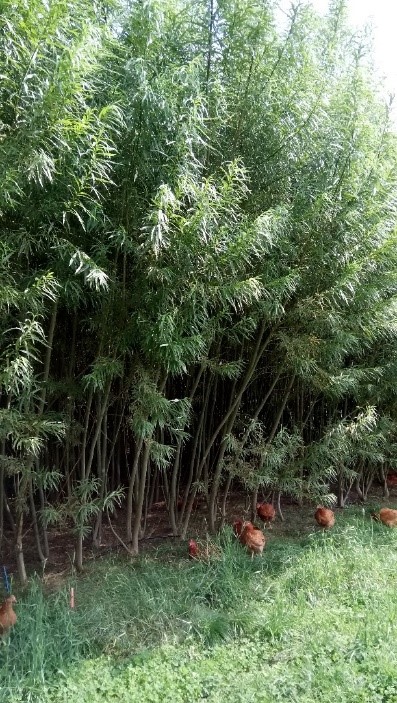Agroforestry with organic chickens: a perfect symbiosis?
In the Freebirds project, two agroforestry systems with chickens and different type of vegetation have been tested





Chickens that are housed in an organic system have ample opportunity to roam around in the free range. Unfortunately, the majority of chickens in a flock stays close to the chicken house and do not use the full range. Staying close to the house in dense populations causes depletion of the soil and its biodiversity and can result in easier transfer of (pathogenic) diseases among chickens in a flock. Enhancing overall range use in a flock by keeping chickens in an agroforestry system may benefit their welfare. In an agroforestry system, plant production and chicken production occur on the same site. It is likely that these two agricultural systems have positive symbiotic effects on each other i.e. fertilization of the soil by the chicken and protection from weather and aerial predators by the trees. Funded by the CORE Organic Freebirds project and the LegComBio project from the Flemish government, we studied these symbiotic effects. We looked at range use of individual chickens in a free range with different plant production types. Biomass, vegetation cover and soil content were investigated in two different plant production types (willow short rotation coppice and small hazel trees). The research took place at the unique experimental site of the Flanders Research Institute for Agriculture, Fisheries and Food (ILVO) in Belgium, where individual chicken could be tracked simultaneously.
Where art thou chicken?
For the two chicken houses (see photo 1 and info box below) the highest percentages of tracked chickens (50 to 75%) were seen at the pop-holes of the chicken house at day-time hours during the tracking period (Fig. 1). In group A, the second largest group of hens was detected nearby the willow zone (45 to 60%). Roughly 25% of the tracked chickens were seen at the larger distance in both the willow and the grass-zones. Interestingly, for both houses the percentage of tracked chickens venturing further from the house into the grass zone increased to approximately 50% around 6–7 p.m. When temperature increased, we noticed that the percentage of chickens registered near the house in the willow-zone was almost equal to the percentage of birds registered at the pop-holes of house (Fig. 2).
What’s in it for the plant?
In the willow zone, no differences in biomass were found between samples taken close to (high chicken density) or far from (low chicken density) the chicken house. Indications existed that hazelnuts close to the house produced slightly more nuts than trees far from the house. Higher levels of residual nitrate, organic carbon, phosphorus and potassium content were seen close to the house as compared to far from the house. Weed pressure was higher further from the house as compared to zones close to the house. Grass pressure was lowest close to the house.
How to interpret?
Based on our tracked-chicken data, the majority of chickens were registered at the pop-holes at any given hour of the day. This could mean that there was a high activity of entering or exiting the chicken house. For the other zones, we assessed passage on or over the antenna, but do not know where the chickens were when they were not registered. Despite this disadvantage we still have registrations of 45 to 60% of the chicken in house A (but not house B) to range in the willow zone. These high percentages indicate that the willows attract the chicken to this area. The observation that more chicken were registered in the willows at higher temperatures supports the hypothesis that the trees have a stimulating effect on range use i.e. in comparison to grassland with small hazelnut shrubs (50% vs. 30%). The soil and plant cover results also indicate that a more equal distribution of chickens over the range is needed to limit negative effects on the soil and the vegetation. Hazelnuts seem to produce well in conjunction with egg production by chickens, and the willows themselves do not have positive or negative influence on high or low density occupation of chicken. Hence, both plant systems seem suitable for agroforestry systems with chicken. In conclusion, planting trees appears to be useful to stimulate ranging behaviour in chickens. Moreover, a good harvest can be achieved with this form of agroforestry or mixed land use, so that it can also be marketed to generate extra income and/or diversification.
| Study site and design |
|---|
During three years of research (2017–2019), we studied the combination of keeping organic laying hens (Novogen Brown; Gallus gallus domesticus) in a free-range and the cultivation of two different types of vegetation: dense shelter under short rotation coppice (willow, Salix sp.) and more open vegetation in the form of hazel trees (Corylus avellana cvs.) on grassland. The experimental site contained four blocks (A, B, C and D) of equal form and size (42,5 x 42,5 m²), see Photo 1. In two blocks (A and D) a ratio of 6/7 grass-seeds and 1/7 clover seeds (Trifolium repens) were sown in 2013. In the same year, willow-clones (Salix spp., Tora, Klara and Tordis) were planted (blocks B and C) for the production of short rotation coppice with clover as groundcover. Hazelnut trees were added to the grassland plots in 2017 (named grass-zone hereafter). Biomass levels of both vegetation types and plant biodiversity of the groundcover were compared between zones close to and far from the chicken house, as well as with control plots. Soil contents (residual nitrate, organic carbon, phosphorus and potassium) were also compared between the different plots. |
| Tracking chickens |
|---|
Two production rounds of laying hens were kept from 18 to 70 weeks of age (n = 204 chicken per round). Hens were housed in one of two mobile chicken houses (Photo 2). Each house contained two compartments, each housing 51 hens under EU organic regulations. In the second production round (2018–2019), hens were individually tracked with the use of a Radio Frequency Identification Detection (RFID) method. This RFID method allowed to assess where individual hens had been. Each hen was equipped with a leg-band holding its unique identification code. Our RFID system consisted of wire antennas with a length of 40 m, and registered when a specific chicken passed over it with a time stamp and ID code. Tracking was done per house of two compartments every 2 weeks at different parts of the free range: 1st at the pop-holes of the mobile house; 2nd in the grass-zone (15 m from the house); 3rd nearby the willow zone (5 m from the house) and 4th in the willow-zone (15 m from the house). With the use of this tracking data we could assess the use of the range by the percentage of chickens per compartment in different zones. From that data, a preference for the different vegetation types could be deduced. From registrations of chickens at the pop-holes time-stamps were compared to assess free range use. Percentages of chickens using the free range were plotted against the temperature per hour of the day, but because of tracking per zone over two weeks unfortunately only temperature ranges between 16 to 24 could be compared between all zones. |
Authors
Elske N. de Haas1,3; Jolien Bracke2; Bert Reubens2; T. Bas Rodenburg1; Frank A. Tuyttens3
Animals in Science and Society, Department of Population Health Sciences,Faculty of Veterinary Medicine, Utrecht University, Utrecht, The Netherlands; Flanders Research Institute for Agriculture, Fisheries and Food; Department of Plant Science, Department of Animal Science, Melle, Belgium
Corresponding author: frank.tuyttens@ilvo.vlaanderen.be
Editor: Karin Ullven / Design: Christine Dilling
